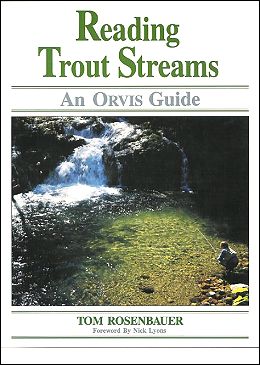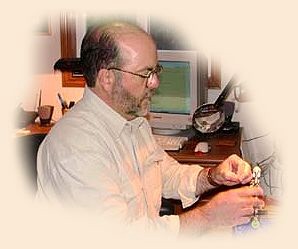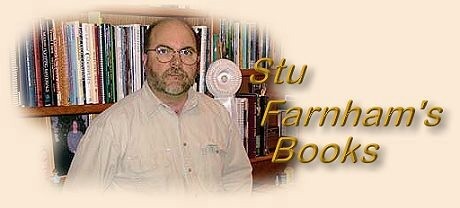|
The Internet is a powerful resource. It provides us instant
access to information, and brings us together via email,
bulletin boards, chat rooms, and instant messaging. FAOL
is a wonderful example of the Internet at its best. The Internet,
however, will never replace the printed page.
I've loved books and fishing since my youngest years, although
I did not start fly fishing until 1993. This column will give
me an opportunity to share reviews of some of my favorite fly
fishing and tying books (and some that are not such favorites)
with my friends here at FAOL. My library reflects my tastes
and interests, and so will this column. It will be heavily
slanted towards cold water fishing and tying for trout and
steelhead, and won't touch much on areas of which I know little,
such as warm or salt water fishing.
I hope that these reviews will motivate some of you to pick up
a good book, on this or any subject, and read.
~ Stu Farnham
Reading Trout Streams
 Reading Trout Streams: An Orvis Guide
Reading Trout Streams: An Orvis Guide
By Tom Rosenbauer
Paperback and Hardcover: (160 pages)
Publisher: The Lyons Press;(1988)
ISBN: 1-55821-933-1
Tom Rosenbauer (like Dave Hughes) is one of those
authors whose name on a fly fishing book immediately
puts it on my 'buy' list. Rosenbauer is vice-president
of marketing for Orvis in Manchester, VT, and author
of a number of books published under Orvis' name. His
Orvis Guide to Fly Fishing was my primer
for the sport.
Reading Trout Streams has recently been reissued under the name
The Orvis Guide to Reading Trout Streams. Since
I have the original 1988 edition in my library, that's what
I'll review here.
Most novice fly fishers focus on casting as the key skill,
and then move on to fly selection. While casting is clearly
fundamental, and fly selection important, I like to emphasize
two other skills when working with novice and intermediate
fly fishers. If you can't read the water, it is hit-or-miss
as to whether you'd put your fly over fish. And, despite my
love of fly tying, I'm firmly in the presentationist school.
This book is an exhaustive treatment of stream structure as
it relates to fly fishing. In order to determine where trout
hold, the fly fisher must understand what the trout needs in
its habitat, and how it feeds. Rosenbauer's first chapter
provides an overview of these topics. Chapter two discusses
the fundamental components of stream hydrology, currents and
rocks. He explains how underwater features manifest themselves
on the surface, and describes cross-sectional variations in
currents. All of these are related to preferred holding
patterns for fish.
With these basics in place, the next chapter introduces the
other variations in stream structure: logs, banks, curves,
and other obstructions. Rosenbauer then assembles all of
these component parts into a complete model of a trout stream,
with the macro features in terms of which we tend to think
and speak: pools, riffles, flats, and pocket water. The
chapter on pools contrasts the head, middle, and tailout
and talks about how to read and fish each section.

The chapter titled 'Big Rivers and Little Pools' takes issue
with the conventional wisdom that you should "fish a gigantic
river as you would a little stream, dividing it up in your
mind before you start." The rest of the chapter goes into
depth on how Rosenbauer approaches these two very different
kinds of fishing.
Moving water changes in all four dimensions, and there is a
chapter that deals with daily and seasonal variations. Tom
closes the book with two important but often overlooked
subjects: approach and etiquette.
The book is illustrated with informative line drawings and
clear black and white photographs. ~ Stu Farnham
About Stu
 Stu Farnham is a New Englander by birth, who was transplanted to
and put down roots in Oregon in the early 1990s, now residing in
the Seattle area. A software engineering manager by vocation,
he can be found in his spare time chasing trout and steelhead
in the rivers of the Pacific Northwest, chasing his four Gordon
Setters (who in turn are chasing chukar), tying flies, reading,
or working on his website. Colleen, his long suffering wife of
28 years, is a professionally trained personal chef.
Stu Farnham is a New Englander by birth, who was transplanted to
and put down roots in Oregon in the early 1990s, now residing in
the Seattle area. A software engineering manager by vocation,
he can be found in his spare time chasing trout and steelhead
in the rivers of the Pacific Northwest, chasing his four Gordon
Setters (who in turn are chasing chukar), tying flies, reading,
or working on his website. Colleen, his long suffering wife of
28 years, is a professionally trained personal chef.
|

 Reading Trout Streams: An Orvis Guide
Reading Trout Streams: An Orvis Guide
 Stu Farnham is a New Englander by birth, who was transplanted to
and put down roots in Oregon in the early 1990s, now residing in
the Seattle area. A software engineering manager by vocation,
he can be found in his spare time chasing trout and steelhead
in the rivers of the Pacific Northwest, chasing his four Gordon
Setters (who in turn are chasing chukar), tying flies, reading,
or working on his website. Colleen, his long suffering wife of
28 years, is a professionally trained personal chef.
Stu Farnham is a New Englander by birth, who was transplanted to
and put down roots in Oregon in the early 1990s, now residing in
the Seattle area. A software engineering manager by vocation,
he can be found in his spare time chasing trout and steelhead
in the rivers of the Pacific Northwest, chasing his four Gordon
Setters (who in turn are chasing chukar), tying flies, reading,
or working on his website. Colleen, his long suffering wife of
28 years, is a professionally trained personal chef.